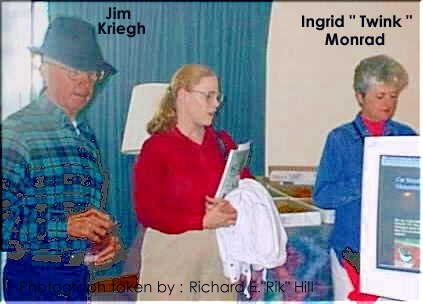

Like many of you, I have enjoyed many years of rockhounding. I never dreamed that this hobby would lead me into an adventure of discovery that reached to the stars -- to a meteorite field 20,000 to 25,000 years old! I often go rock or gold hunting with a friend named Jim Kriegh. Sometimes his friend John Blennert also goes. The two of them had occasionally gone to a well-known gold hunting area called Gold Basin in northwest Arizona. They use metal detectors to search for gold nuggets.
Dr. David Kring, a meteoriticist from the University of Arizona, had spoken to our local gold club, Desert Gold Diggers, and encouraged those who use metal detectors to keep an eye and ear out for meteorites. Jim had evidently paid good attention, because on a gold outing south of Tucson in 1995, he found what turned out to be a stone meteorite, later named the Greaterville meteorite.
Jim had taken this stone to Robert Haag, one of the world's foremost meteorite dealers who happens to live in Tucson, who identified it as a meteorite and urged Jim to take it to the University of Arizona for study. Back again in Gold Basin, Jim kept hearing rocks which sounded like gold, but did not appear to contain gold.After cutting all of the rocks he collected, Jim took two of these to Dr.Kring in November 1995. He found they were stone meteorites, and asked Jim to advise him if he found any more in the area. I was fortunate to be included in the next trip to Gold Basin, my first visit there. We left with our camp equipment, generator and power saw to cut any likely specimens we would find and try to determine what we were finding.
John and Jim, who were more experienced in detecting minerals, came back to camp with numerous rocks. I was still learning how to use my detector, a Goldmaster II, which is the brand John and Jim also use. Several times a day we would bring back a group of rocks which made noise and were magnetic. Jim sawed all of them open; some were meteorites and some were not. As the week progressed, we became more aware of how the meteorites looked, and soon we were not sawing all of them.
We took the group of good ones to the U of A, and Dr. Kring seemed very excited that we in fact had discovered a true strewn field. He asked us to write an index card for each meteorite we found, with notes on gram weight, date, and whether it was found on the surface or the depth if buried. We also began to mark where each meteorite was found by putting pinpoints on a topo map, but it soon became apparent that there would be too many, so Jim began numbering them as groups. A further request of us was that we would tell no one about this find, so that the University of Arizona could properly study the area for two years. Suddenly we three became a team to assist the University of Arizona. We have now found over 2,000 meteorites, and have expanded the field boundaries to five miles by 13 miles. It is not known how large the field really is.
David Kring has told us that tests show that these are L4 stone meteorites, which fell between 20,000 and 25,000 years ago, near the end of the Ice Age. The condition of the stones is remarkable due to the dry air of the high desert plateau, although they are obviously weathered. Some have nice fusion crust, some are pieces which broke apart upon impact,and we understand the whole meteorite was between one and two meters in size. Dr. Kring has called this a "fossil strewn field", the only one ever found outside of Antarctica.
Gold Basin is a fun place to hunt because when listening for these rocks from space, gold nuggets are occasionally found -- a nice bonus! It is also interesting to be there with David Kring of University of Arizona, as he is a meteoriticist, planetary scientist and geologist. He was with us during the passage of the Hale-Bopp comet, and we were able to learn more about that by being with him. He also brought to our attention the numerous satellites which are constantly moving above.
The only light in the area is a faint glow over a mountain
range which turns out to be from Las Vegas, so the
star gazing is spectacular. As one prepares dinner, a gorgeous sunset is usually in the
making -- a reward for a hard day's work. Now that the field has been made public, perhaps some of you who metal detect will want to go to Gold Basin, which is in Mohave County, northwest Arizona. The University of Arizona press release is available